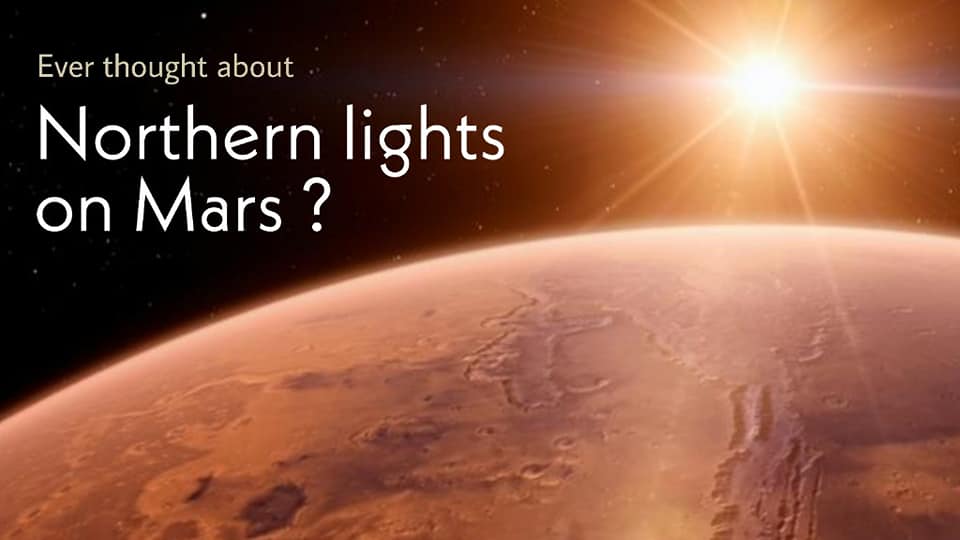Ever thought about auroras on Mars?
Auroras (a.k.a northern and southern lights here on earth) are just spectacular! That night sky lit with green and pink lights is so eye-catching. But, do auroras occur on Mars?
Let’s have a look.
Auroras on Mars vs. Auroras on Earth
What Causes Auroras on Mars?
How were they first detected?
It also tells how Mars became a dry world
Why do proton auroras not occur on Earth?
Yes, Auroras occur on Mars but they are little different compared to here on earth.
Here are the key differences:
Auroras on Mars are in UV range while here on earth they are in Visible range.
Here on Earth, auroras are seen at popes whereas on Mars they can be seen round the globe on day side.
Would you be able to see these auroras when you visit Mars?
No and Yes. Auroras on mars are not visible to the naked eye, because they are not in the visible range, but in the UV range. So don’t forget to take along your Ultraviolet sensitive Goggles on your visit to Mars. Yes, interplanetary tour! 🙂
A question might arise in your curious mind: why is it called “PROTON” auroras? Are protons somewhere involved in the mechanism of how these are produced? Yes, you are right. Let me explain how. Starting from Basics.
In brief, What are Auroras?
It’s very simple Physics.
It all starts from Solar winds. Ejected from the Sun, Solar winds are streams of hot and highly energetic charged particles i.e electrons and ions moving at very high speeds of more than 3 million km per hour.
When those high-speed incoming particles interact with atoms in the upper atmosphere, light is given off. That’s what we call auroras.
Let’s dive deep into the mechanism of proton auroras on Mars.
What Causes Auroras on Mars?
Solar winds also consist of Hydrogen atoms with their electrons stripped away by intense heat. A Hydrogen atom without its electron is basically a proton.
As protons approach Mars, the protons coming in with the solar wind transform into neutral atoms by stealing electrons from huge hydrogen cloud surrounding the planet mars. When those high-speed incoming atoms hit the atmosphere, some of their energy is emitted as ultraviolet light.
And that’s how proton auroras on mars are caused.
Spacecraft was first to see them on Mars
As proton auroras on mars are in UV range, it is invisible to the human eye but detectable to the Imaging UltraViolet Spectrograph (IUVS) instrument on the MAVEN spacecraft.
“The MAVEN (Mars Atmosphere and Volatile EvolutioN) team was studying Mars’ atmosphere with the Imaging UltraViolet Spectrograph (IUVS) and observed that on occasion, the ultraviolet light coming from hydrogen gas in Mars’ upper atmosphere would mysteriously brighten for a few hours. They then noticed that the brightening events occurred when another MAVEN instrument, the Solar Wind Ion Analyzer (SWIA), measured enhanced solar wind protons.”
It also tells how Mars became a dry world
In its youth, Mars also had water and a thick Atmosphere, as researchers believe. So, how did it became dry as it is now? Where did all of its water go? Here’s the explanation.
This MAVEN spacecraft first observed these auroras in 2016 and thus had a chance to study it for several years. The MAVEN team used these data taken over multiple years and found that these auroras are strongest during summer in the southern hemisphere when Mars is closest to the sun.
The correlation with the southern summer gave a clue as to why proton aurora is so common and how it could be used to track water loss.
It’s also the time when the whole planet is warm and more water vapors are pushed to the upper atmosphere, where ultraviolet light breaks it apart into hydrogen and oxygen. The light hydrogen being lightly bound by Mars’ gravity, it adds to the hydrogen Corona – a huge hydrogen cloud surrounding Mars, increasing hydrogen loss to space
This can be considered a strong explanation of how water escaped mars. Over time, water escaped Mars, and the planet became increasingly dry. This is part of the reason Earth and Mars are so different today, even though they were once very similar.
Why do proton auroras not occur on Earth?
Proton auroras do occur at Earth, but not as often as at Mars. There are two major reasons.
- It is due to the Earth’s strong magnetic field, which diverts the solar wind (and solar wind protons) away from Earth to a much greater degree as compared to Mars. (As Mars has very weak magnetic field)
- Another condition required for proton auroras to occur is the presence of large proportion of Hydrogen in the upper atmosphere, which is lacking in Earth’s atmosphere
So, on Earth, proton auroras only occur in very small regions near the poles, whereas at Mars they can happen everywhere.
Proton Auroras on other Planets.
However, proton auroras could be common on Venus and on Saturn’s moon Titan. Like Mars, these two worlds lack their own magnetic fields and have lots of hydrogen in their upper atmospheres—with plenty of electrons to share. Looking further, it’s likely that many planets orbiting other stars have the same favorable conditions, and would be likely to have proton auroras too.
